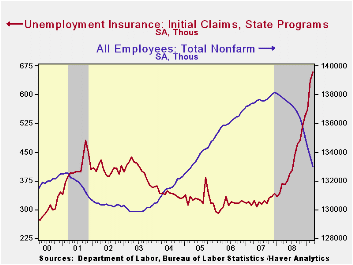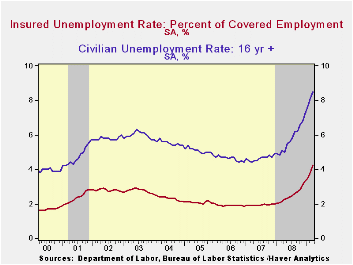 Global| Apr 16 2009
Global| Apr 16 2009U.S. Initial Claims for Unemployment Insurance Fall Back
by:Tom Moeller
|in:Economy in Brief
Summary
Initial claims for unemployment insurance gave another indication that the worst of the labor market's deterioration is moderating. The level of 610,000 claims last week was down from an upwardly revised 663,000 and it was the second [...]

Initial claims for unemployment insurance gave another indication that the worst of the labor market's deterioration is moderating. The level of 610,000 claims last week was down from an upwardly revised 663,000 and it was the second consecutive weekly fall. Consensus expectations for 660,000 claims.
The Labor Department indicated that the largest increases in initial claims for the week ending April 4 were in Michigan (+5,408), Missouri (+4,986), Texas (+3,734), New Jersey (+2,368), and Pennsylvania (+2,194), while the largest decreases were in California (-4,708), Ohio (-2,716), Alabama (-2,421), Florida (-1,539), and Wisconsin (-1,078).
Continuing claims for unemployment insurance reached yet another record high of 6,022,000 and now they have more than doubled the year ago level. The series dates back to 1966. The four-week average of continuing claims also rose to another record of 5,796,000. Continuing claims provide some indication of workers' ability to find employment and they lag the initial claims figures by one week.
Though the latest level of continuing claims was a record, the labor force has grown as well, by nearly 30% over the last twenty years. Therefore, the insured rate of unemployment is not at a record high. It rose slightly to 4.5% which was the highest since 1983. During the last ten years there has been a 93% correlation between the level of the insured unemployment rate and the overall rate of unemployment published by the Bureau of Labor Statistics.
The 4.4% insured unemployment rate by far understates labor market distress in some states. The highest insured unemployment rates in the week ending March 28 were in Michigan (8.0 percent), Oregon (7.9), Rhode Island (7.1), Idaho (7.0), Wisconsin (7.0), Pennsylvania (6.7), Nevada (6.2), Alaska (6.0), Montana (6.0), and Vermont (5.9).
Employment covered under the unemployment insurance program has risen sharply. The Labor Department indicated that 133.9 million workers were covered and that total amounts to 87% of the civilian labor force. The percentage has been roughly stable for the last ten years but it is up sharply from 60% to 65% in the mid-1970s.
The unemployment insurance claim data is available in Haver's WEEKLY database.
Recession or Depression? Part II from the Federal Reserve Bank of St. Louis can be found here.
What's Under The Tarp?, also from the St. Louis Fed, is available here.
| Unemployment Insurance (000s) | 04/11/09 | 04/04/09 | 03/28/09 | Y/Y | 2008 | 2007 | 2006 |
|---|---|---|---|---|---|---|---|
| Initial Claims | 610 | 663 | 674 | 65.3% | 420 | 321 | 313 |
| Continuing Claims | -- | 6,022 | 5,850 | 102.4% | 3,342 | 2,552 | 2,459 |
Tom Moeller
AuthorMore in Author Profile »Prior to joining Haver Analytics in 2000, Mr. Moeller worked as the Economist at Chancellor Capital Management from 1985 to 1999. There, he developed comprehensive economic forecasts and interpreted economic data for equity and fixed income portfolio managers. Also at Chancellor, Mr. Moeller worked as an equity analyst and was responsible for researching and rating companies in the economically sensitive automobile and housing industries for investment in Chancellor’s equity portfolio. Prior to joining Chancellor, Mr. Moeller was an Economist at Citibank from 1979 to 1984. He also analyzed pricing behavior in the metals industry for the Council on Wage and Price Stability in Washington, D.C. In 1999, Mr. Moeller received the award for most accurate forecast from the Forecasters' Club of New York. From 1990 to 1992 he was President of the New York Association for Business Economists. Mr. Moeller earned an M.B.A. in Finance from Fordham University, where he graduated in 1987. He holds a Bachelor of Arts in Economics from George Washington University.






